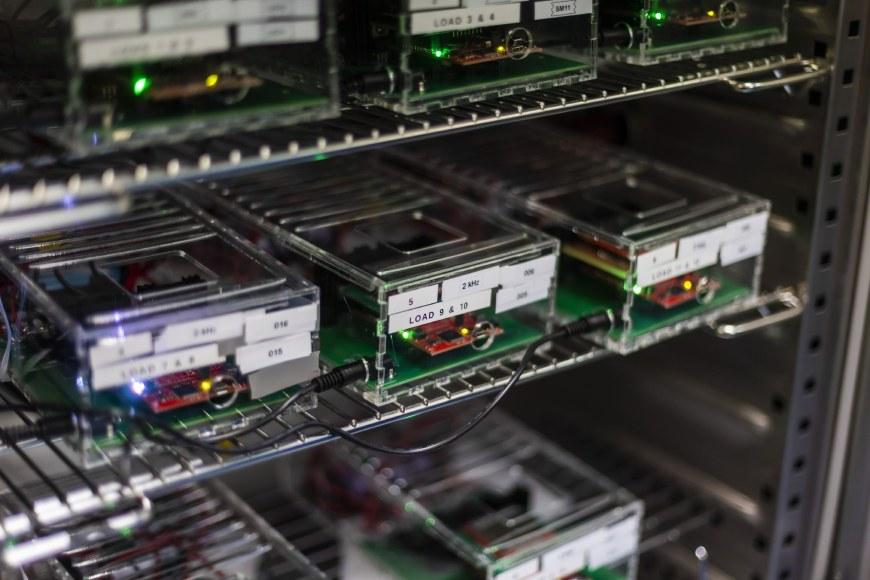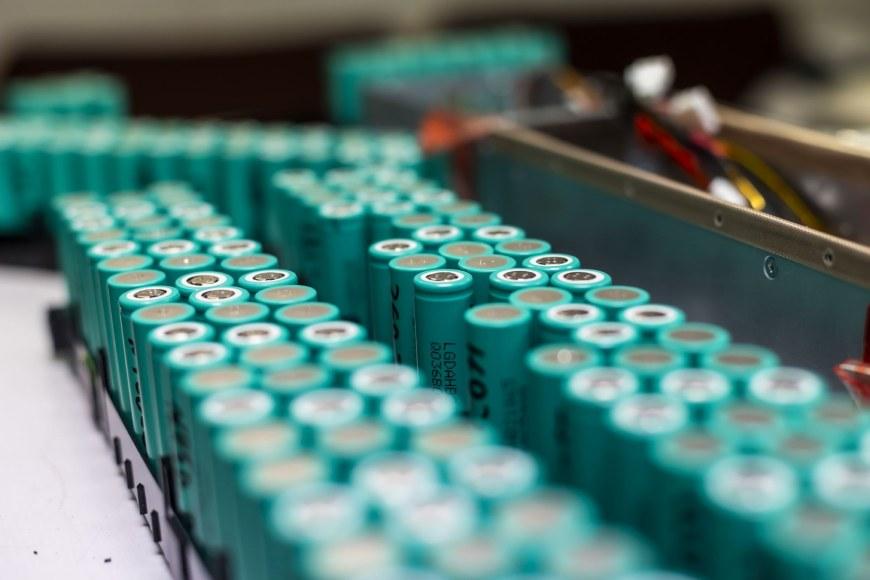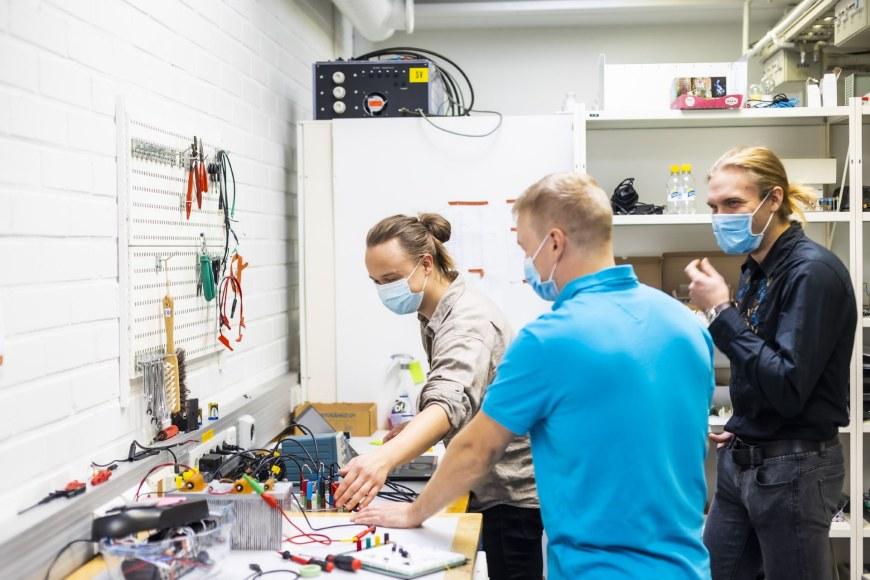One rotten egg spoils the whole omelette, which is why batteries also break before their time

This article was originally published in Unit, the magazine of Tampere Universities.
Back in the 1990s, unplugged meant an acoustic gig on Music Television. Today it means the end of life as we know it.
Our everyday lives are increasingly dependent on electricity. Our grandparents had a fridge and a radio while we charge our phone, tablet, laptop, drill, vacuum cleaner, toothbrush, scooter, bicycle, and car – just to name a few.
Along with the growth of digitalisation, a green shift from oil-based fuels to electricity is happening especially in transport. We need clean energy in the fight against global warming. At the same time, however, we need batteries and more minerals to power them than the earth can provide.
“That is why we should be able to use the current batteries more efficiently,” researcher Roni Luhtala from the CeLLife research project says.
“Perhaps 50–80% of battery cells are still in a good condition when the battery is recycled. The batteries of electric scooters are a prime example. Their battery cells are usually only used up to maybe 10% of their capacity at the time of recycling,” Luhtala adds.
It is idiotic to crush something that clearly has some use value left.
CeLLife is a research project begun at Tampere University in January 2021. Researchers of electronic engineering Luhtala, Jussi Sihvo and Tuomas Messo have developed a new measurement method to gauge the condition of batteries and make safe recycled batteries.
“We see a business opportunity in recycled batteries, but the other major reason for our research project is purely ideological. It is idiotic to crush something that clearly has some use value left. We want to step into boots in which nobody has walked before,” Messo says.
A battery is like a carton of eggs
We need a metaphor to understand what is at stake. Messo knows batteries like the contents of his fridge and finds an apt metaphor in eggs.
“A battery is like a carton of two dozen eggs. The cells that make up the battery are like the individual eggs inside the carton,” Messo explains.
To understand why a battery does or does not hold its charge, you do not need to master electro-physics. All you need is to know how to make the omelette. For example, the lithium-ion battery of an electric bicycle contains 20-80 cells depending on its size, while an electric car’s traction battery consists of thousands of cells. When a battery stops working, most of the cells are often still intact and fully functional.
“If one of the eggs in an omelette is rotten, the whole omelette is ruined. This principle mostly applies to batteries,” Messo points out.
Digital fingerprinting is the basis of rechargeable batteries
In CeLLife diagnostics, a tester and computer software can distinguish between working and faulty battery cells. Within seconds, an electronic fingerprint is created on the cell, which records the cell’s electrical characteristics.

The electronic fingerprint is important because it allows cells to be grouped according to their condition and similar characteristics. This allows cells to be used to build batteries safely.
CeLLife started by studying the batteries of electric bicycles and scooters. A pilot project on hybrid car batteries is in progress.
“For a battery to work, all the cells must be in the same condition. Our idea is that cells from, for example, electric car batteries could be used to make rechargeable batteries for lighter vehicles, appliances, or electricity storage. This would extend the life of the cells as they are,” Luhtala says.
Earth’s metals are not enough to keep up with the pace of development
Stopping the use of carbon-containing fossil fuels, shifting to carbon-free energy and the electrification of society are controversial mega-trends. It is obvious that CO2 emissions must be reduced. The problem is that when we choose one approach, we have to say no thank you to other approaches.
Both batteries and the zero-emission solar and wind power needed to charge them require large quantities of rare-earth minerals, such as silicon, cobalt, copper, and iron. Big mines must be built, and they are always in someone’s backyard. Mines pollute the surrounding environment, and the processing of minerals requires energy, which in turn produces carbon emissions that warm the atmosphere.
Many battery-powered devices are left gathering dust in the corners of homes after active use.
Ari Jokilaakso, professor of metallurgy at Aalto University in Finland, has summed up the problem of the green transition: there are not enough mineral raw materials to meet the needs of the green transition, renewable energy, and energy storage.
“Renewable energy production creates a need for metals, which in turn increases the need for renewable energy, which creates a spiral that greatly increases the need for metals. This self-fulfilling spiral will lead to the depletion of some mineral raw materials or their production capacity in as little as 5-10 years,” Jokilaakso says.
The paradox is that the cleaner we want our local energy to be, the more we must accept sacrificing the environment and people on the altar of green transition in places that we cannot see.
CeLLife-sized niche in the circular economy
Global electrification issues and the problems with batteries are familiar to Liisa-Marie Stenbäck, CEO of Recser. As a producer organisation under the Waste Act, Recser is responsible for recycling batteries and smaller lithium-ion batteries on behalf of Finnish importers and manufacturers.
The technical capacity to recycle different types of lithium-ion batteries is already quite good. The batteries of, for example, phones and small electric appliances contain much cobalt. They can be efficiently recycled, and the raw materials contained in the batteries – such as cobalt, copper, nickel, and iron – can be recovered.
“In practice, however, recycling still recovers very small quantities of battery metals partly due to the long life of batteries and low recycling. Many battery-powered devices are left gathering dust at homes after active use,” Stenbäck says.
“As the demand for batteries grows, it makes sense to make batteries last as long as possible. Currently, smaller batteries are virtually not reused in Finland, and that needs to change,” Stenbäck adds.

From the circular economy perspective, the key is at the design table.
“Regulation and other guidance must be able to influence product design so that batteries are not only easy to recycle but also have the longest life possible and are potentially repairable and reusable," says Stenbäck.
Hybrid and electric car traction batteries are recycled by Suomen Autokierrätys. Recycling expertise and capacity for these and other large industrial lithium-ion batteries is developing in Finland. There is huge potential in their reuse.
“Promoting the reuse of whole batteries and their components accords with the definition of priority waste under the Waste Act and is vital for promoting the circular economy. Reuse is justified for both climate reasons and the material shortages that are due to the rapidly increasing use of batteries,” says Stenbäck.
The raw material shortage of battery metals has two faces
The big battery shortage is due to both the COVID-19 pandemic, which has slowed down metal production, and the growing demand for battery metals especially caused by the electrification of society. The first reason is likely to level off while the second is not.
In the EU, for example, the target is to have 30 million electric cars on the roads by 2030. At the same time, the demand for batteries of lighter vehicles, tools, and IT will increase. The estimates of the increase in demand range from 10- to 20-fold.
NOSTO: By carefully matching the cells, a battery’s life can be extended as much as by 25%. “This is starting to be reflected in component prices,” CeLLife's Jussi Sihvo says.
According to Bloomberg media, as recently as in 2010, the price of a lithium-ion battery was $1.200 per one kilowatt hour. With technological and production advances, the price has plummeted to $135.
“Prices have fallen annually towards the $100 landmark, but now, for the first time, there are indications that the prices may also begin to rise. The price may fall in the future, but the reversal of the price decline reflects the limited availability of raw materials and the growing demand,” Sihvo points out.
Raw material scarcity has two faces. On the one hand, it boosts recycling, but it does not automatically encourage the reuse of battery cells, as the metals they contain are quickly needed for recycling and to supplement the production of virgin raw materials. On the other, if there are no rechargeable batteries, they will not be missed.
“Thus far, battery recycling has perhaps been dominated by large companies that have been more interested in crushing the batteries back into raw materials than in recycling the battery cells,” Messo says.
Investors need to be convinced of the quality of rechargeable batteries
This year is exciting for CeLLife.
The technology needed to measure cells works and a patent is pending. Next summer, the research project will turn into a start-up company.
“By the end of July, we need to decide in what type of company we will continue and how we will productise our measurements,” Messo says.

There are two options. The company could set up its own testing and production facilities for manufacturing recycled batteries. A more likely option is licensing the technology to other actors in the battery business that already have the necessary production infrastructure. The innovation could also be used in the production of new batteries.
“A battery often breaks down before its time because it contains a faulty or unsuitable cell. By carefully matching the cells, battery life can be extended by up to a quarter,” says Sihvo.
The start of CeLLife was enabled by Business Finland’s Research to Business funding. The leap of setting up a start-up company also means finding investors. It is rarely easy to get money, but according to Messo, it is currently easier to get investors excited about start-ups than it was a few years ago.
“Our methods fit pretty well with current thinking and the global situation. But if people are not convinced of the suitability of used battery cells for recycling, we still have our work cut out to change that mindset,” Messo adds.
Without recycling there are not enough metals
- The traction battery of one car requires cobalt, nickel, and lithium. The amount of cobalt has decreased in batteries, but the demand for lithium has increased due to its lightness.
- As the number of electric cars grows, so does the amount of minerals needed for the vehicles’ batteries. By 2040, the demand for cobalt is projected to increase by 42-fold, cobalt by 21-fold and nickel by 19-fold compared to the present situation. As digitalisation advances, there will be increasingly many devices that have a battery.
- Large mines and quarries are needed to extract metals with processes that run a high risk of polluting the surrounding environment and jeopardising biodiversity.
- The extraction of lithium for batteries consumes water in the already arid areas of South America, particularly in Argentina and Chile.
- The processing of metals also consumes energy. The production of one kilogram of nickel, for example, produces emissions equivalent to 10-40 kilograms of carbon dioxide.
- In addition to environmental issues, there are human rights concerns in the producing countries. About 70% of the highly coveted cobalt comes from the Democratic Republic of Congo (DRC) where most of the cobalt that is processed in Finland is mined. In DRC, mining is associated with horrendous working conditions, human rights abuses, and child labour in informal mines.
- DRC’s ranking of 175/189 in the UN Human Development Index is an example of how far mining is from channelling income into raising local living standards.
- There is a growing need to recycle valuable metals and products made of them because most of the easily accessible metal deposits close to the earth’s surface have already been used up.
Author: Juho Paavola








